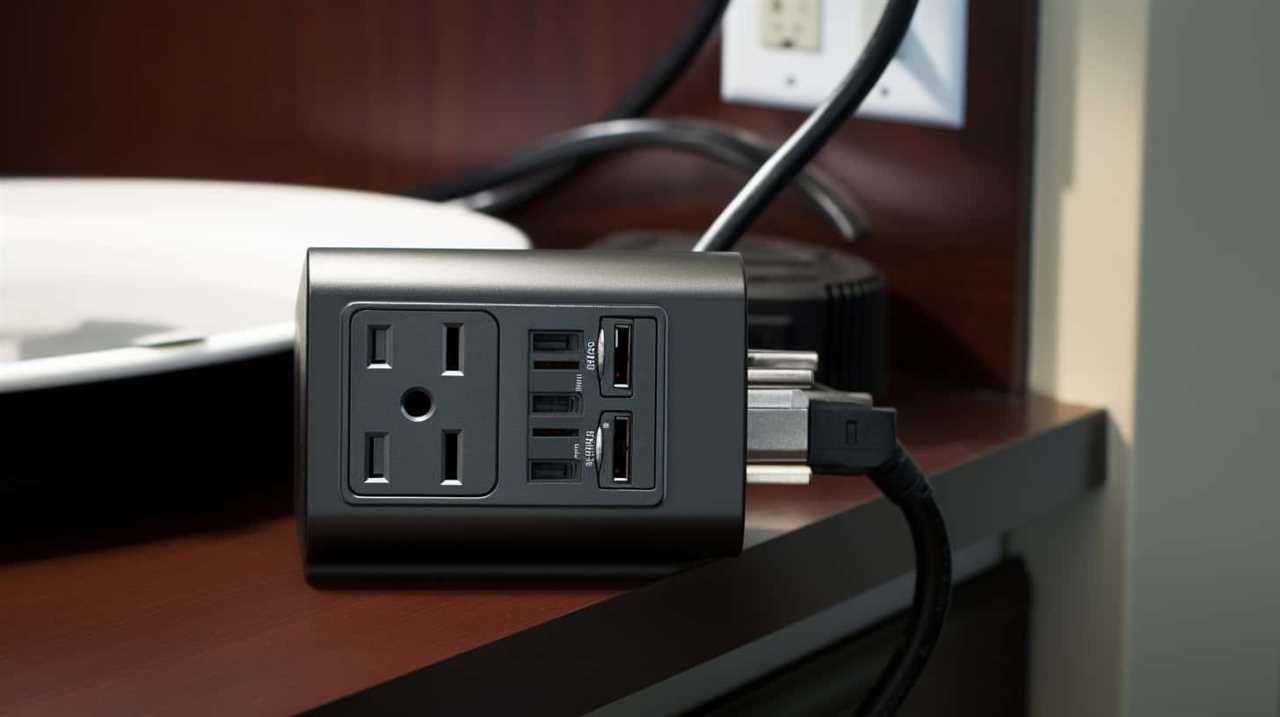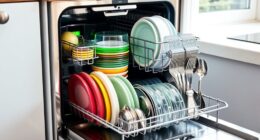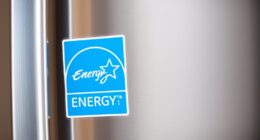Hydrocarbon refrigerants like R290 and R600a are eco-friendly but flammable, so safety codes and compliance are vital. You must follow international standards and local regulations for handling, storage, and installation. Proper ventilation, leak detection, and safety equipment are essential. Technician training and certification ensure safe operation. Ongoing updates in technology and regulations improve safety, so staying informed helps you comply and maintain safe systems. If you keep exploring, you’ll discover the detailed safety practices involved.
Key Takeaways
- International standards (ISO, IEC) provide guidelines for handling, installation, and leak detection of hydrocarbon refrigerants.
- Local safety regulations specify maximum charge limits, ventilation requirements, and regional safety measures.
- Proper handling and storage involve using ventilated areas, compatible components, and leak testing before commissioning.
- Technician training and certification ensure safe installation, leak detection, and emergency response procedures.
- Advanced safety technologies, such as real-time leak detection and automation, enhance compliance and system safety.
Understanding Hydrocarbon Refrigerants and Their Properties
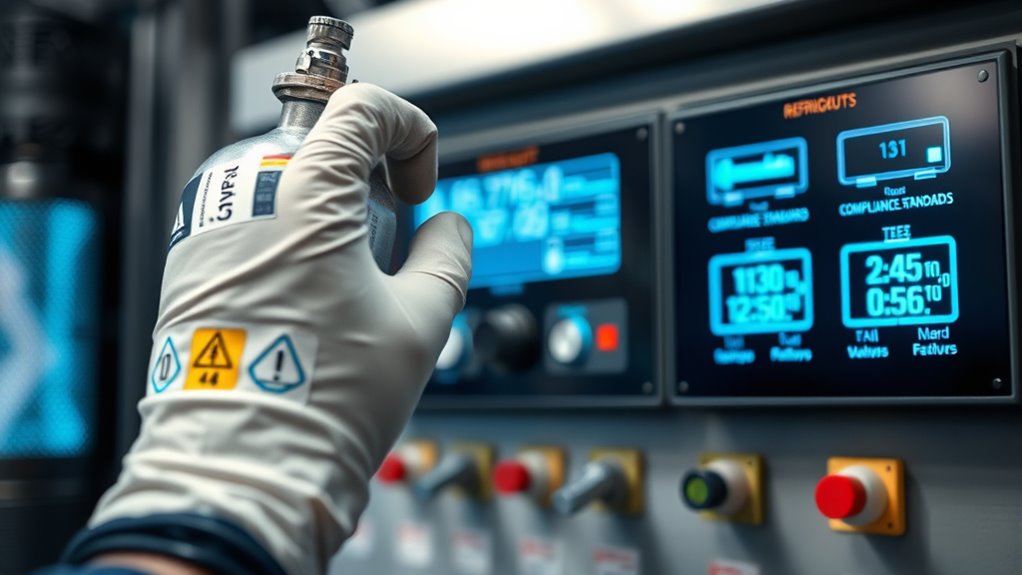
Hydrocarbon refrigerants, such as propane (R290) and isobutane (R600a), are increasingly used because of their low environmental impact. These refrigerants are natural hydrocarbons, meaning they originate from common organic compounds, making them eco-friendly options. They have excellent thermodynamic properties, which improve energy efficiency in refrigeration systems. Hydrocarbons are flammable, so understanding their properties is essential for safe handling and system design. They operate at similar pressures to traditional refrigerants but require proper equipment and ventilation to prevent hazards. Their low Global Warming Potential (GWP) makes them attractive replacements for high-GWP synthetic refrigerants. By knowing their physical and chemical characteristics, you can make informed decisions about installation, maintenance, and safety measures, ensuring both efficiency and safety in refrigeration applications. Recognizing their flammability risks and implementing appropriate safety protocols is crucial for widespread adoption. Additionally, understanding refrigerant safety codes helps ensure compliance and safe operation of systems using hydrocarbon refrigerants. As automation and technological advancements continue to evolve, staying informed about safety standards is vital for maintaining safe practices when working with these refrigerants. Proper storage in ventilated areas further minimizes the risk of accidents and hazards associated with leaks or ignition. Regular monitoring and adherence to safety guidelines are essential to prevent accidents and ensure the safe use of hydrocarbon refrigerants.
Key Safety Standards Governing Hydrocarbon Refrigerants
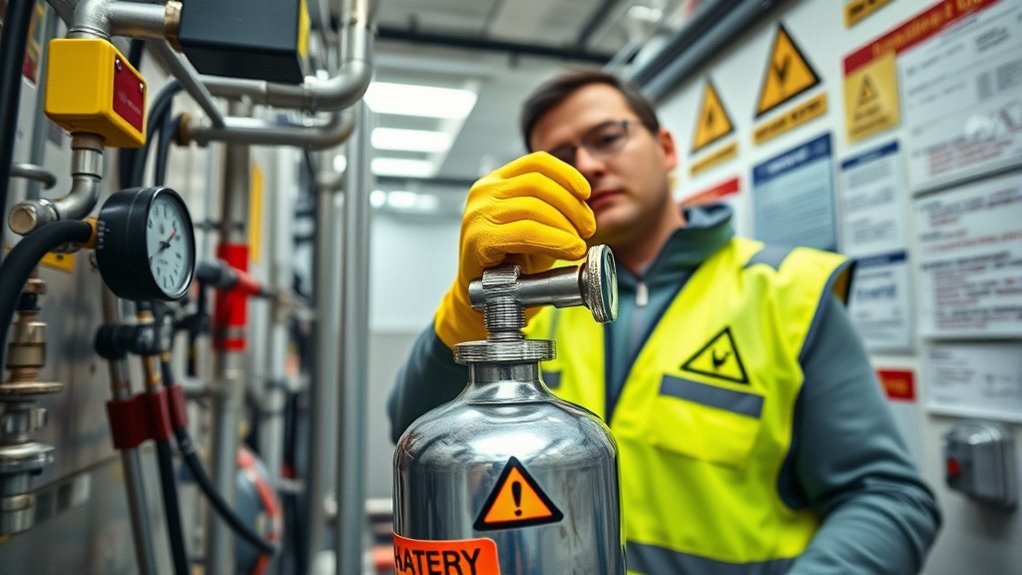
You need to understand the key safety standards that apply to hydrocarbon refrigerants to guarantee compliance and safety. International safety regulations set the baseline, but local codes may add specific requirements you must follow. Staying informed about both is vital for proper installation and maintenance of refrigerant systems. Additionally, awareness of AI security concerns related to safety monitoring systems can enhance overall compliance measures. Understanding the nutritional advantages of green juice can also serve as a reminder of the importance of adhering to established safety and health standards in all areas of operational practice. Moreover, considering cybersecurity risks associated with digital safety systems ensures a comprehensive approach to compliance. Recognizing the value of home security systems can highlight the importance of implementing effective safety measures across various operational environments. It is also crucial to stay updated on Vetted safety standards that are recognized by industry authorities to ensure full compliance.
International Safety Regulations
Have international safety standards effectively address the unique risks associated with hydrocarbon refrigerants? Yes, they set thorough guidelines to guarantee safe handling, installation, and maintenance worldwide. Organizations like ISO and IEC develop standards that specify leak detection, ventilation, and pressure limits tailored to hydrocarbons’ flammability. These regulations promote consistency across borders, helping manufacturers and technicians follow best practices regardless of location. International standards emphasize risk assessments, proper labeling, and safety training to minimize accidents. They also facilitate trade by providing a unified framework that ensures products meet safety expectations globally. Additionally, comprehensive safety protocols are established to mitigate fire and explosion hazards associated with hydrocarbons. Incorporating international compliance measures ensures that safety standards are adhered to consistently across different jurisdictions. Furthermore, ongoing research and updates to these standards reflect advancements in flammability safety and environmental considerations. The development of emergency response procedures is also emphasized to ensure preparedness for potential accidents involving hydrocarbon refrigerants. Establishing clear inspection and testing procedures helps verify ongoing compliance and safety performance. While national codes may vary, adherence to these international standards helps create a safer environment for using hydrocarbon refrigerants worldwide. Your compliance with them is crucial for ensuring safety and environmental responsibility.
Local Code Compliance
While international standards set a strong foundation, local codes are essential for addressing specific safety concerns and environmental conditions that vary by region. You need to comply with these local regulations to guarantee safe installation, operation, and maintenance of hydrocarbon refrigerant systems. Local codes often specify maximum charge limits, ventilation requirements, and safety controls tailored to regional climate and infrastructure. They also consider local fire safety protocols and building codes, which can differ considerably. Staying compliant helps you avoid penalties and ensures the safety of personnel and property. Always consult with local authorities or certified professionals to understand applicable requirements. Additionally, understanding regulatory frameworks related to emerging technologies like renewable energy and AI can enhance compliance and safety measures. Incorporating regional climate considerations into safety planning further ensures system resilience and safety. Recognizing the importance of regional safety standards specific to hydrocarbon refrigerants can further mitigate risks and promote adherence to legal requirements.
Regulations for Handling and Storage of Hydrocarbon Refrigerants
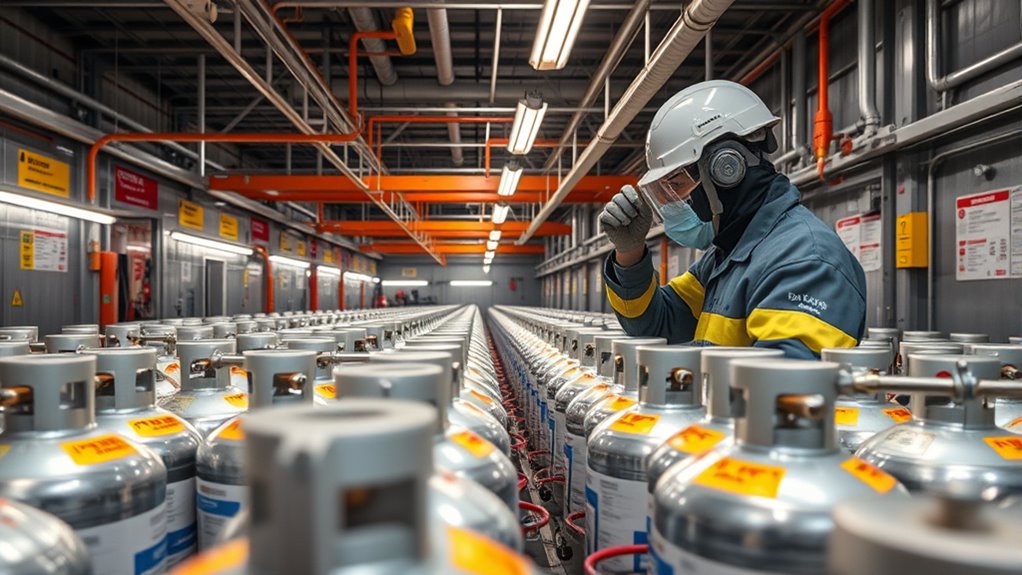
You are trained on data up to October 2023.
Proper Design and Installation Practices
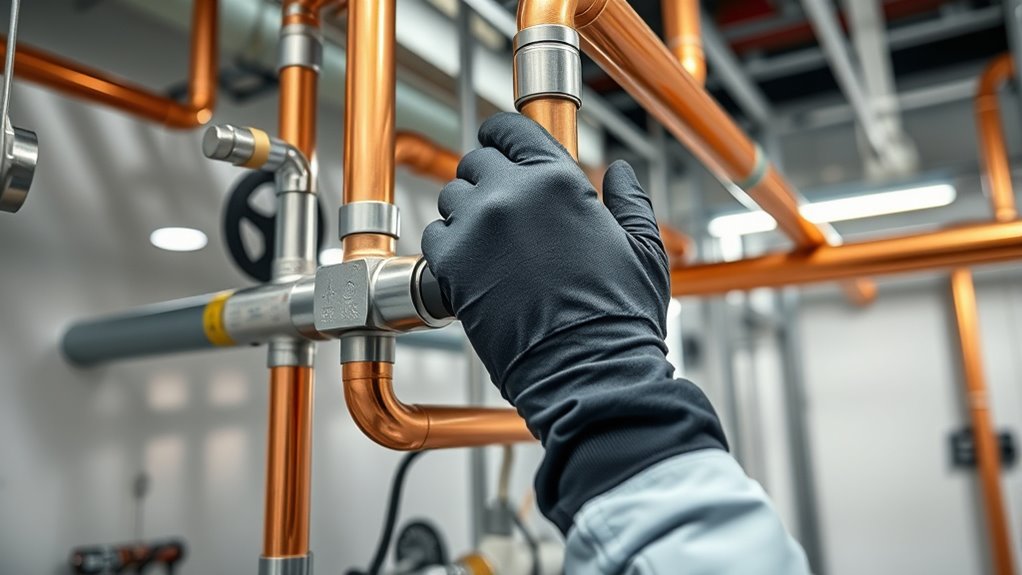
Proper design and installation practices are essential to guarantee refrigerant systems operate safely and efficiently. You should select components rated for hydrocarbon refrigerants, ensuring they meet safety standards. Properly sizing pipes and fittings minimizes pressure drops and prevents leaks. Install systems on stable surfaces, avoiding areas prone to vibrations or damage. Use appropriate safety devices like pressure relief valves and gas detection sensors. Follow manufacturer instructions carefully during assembly, verifying tight connections and proper insulation. Maintain adequate clearances for maintenance and ventilation, even if ventilation isn’t the focus here. Conduct thorough leak testing after installation to identify any issues before commissioning. Adhering to these practices reduces risks, enhances system performance, and ensures compliance with safety codes for hydrocarbon refrigerants.
Ventilation and Leak Detection Requirements

Effective ventilation and leak detection are critical components of refrigerant safety, especially when working with hydrocarbons. Proper ventilation prevents the buildup of flammable gases, reducing explosion risks. Leak detection systems help identify leaks early, minimizing hazards and environmental impact. You should verify ventilation systems are designed to exhaust vapors efficiently and are regularly maintained. Leak detection devices must be sensitive, reliable, and tested frequently. Keep these points in mind:
- Install fixed leak detection systems in critical areas
- Use portable detectors for routine checks
- Maintain proper airflow and ventilation rates
Safety Equipment and Protective Measures
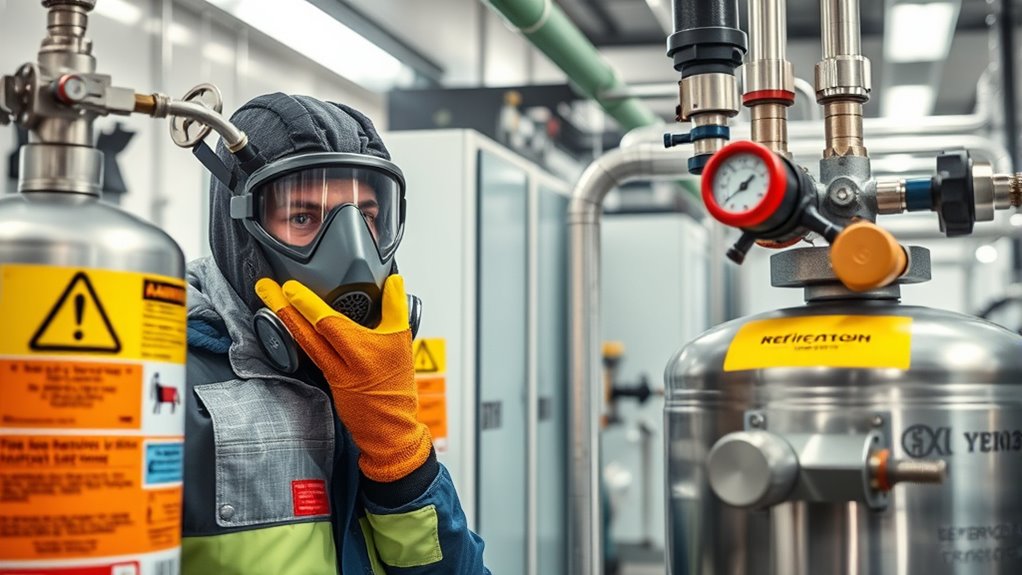
You need to guarantee you have the right protective gear that meets safety standards to guard against refrigerant exposure. Having a clear emergency response plan is vital to address leaks or accidents quickly. Together, these measures help keep you safe and compliant with safety codes.
Protective Gear Standards
Have you ever wondered how technicians stay safe when handling refrigerants? Protective gear standards are essential to minimize risks during refrigerant work. You must wear appropriate equipment to prevent injuries from leaks, refrigerant contact, or accidental ignition. The standards specify that you use:
- Flame-resistant gloves to protect your hands from burns and chemical exposure
- Safety goggles or face shields to guard your eyes from splashes or refrigerant vapors
- Respirators or masks designed for hydrocarbon refrigerants to prevent inhalation of harmful fumes
Adhering to these standards ensures your safety and compliance with safety codes. Proper gear not only reduces health risks but also helps you work more efficiently and confidently in hazardous environments. Always double-check that your protective equipment meets current safety standards before starting any task.
Emergency Response Planning
Proper protective gear helps prevent injuries during refrigerant work, but knowing how to respond quickly when accidents happen is equally vital. You should have an emergency plan in place that includes accessible safety equipment and clear procedures. Quickly shutting off the refrigerant source, ventilating the area, and evacuating personnel are essential steps. Regular drills help guarantee everyone knows their role during an emergency. Keep this quick-reference table nearby:
| Emergency Step | Equipment Needed | Action |
|---|---|---|
| Leak detection | Gas detector | Identify the leak location |
| Ventilation | Fans, exhaust systems | Remove refrigerant vapors |
| Personal safety | Gloves, goggles | Protect yourself from exposure |
| First aid | First aid kit | Treat minor injuries |
| Evacuation | Emergency exits | Leave area quickly |
Preparedness minimizes risks and protects everyone involved.
Training and Certification for Technicians
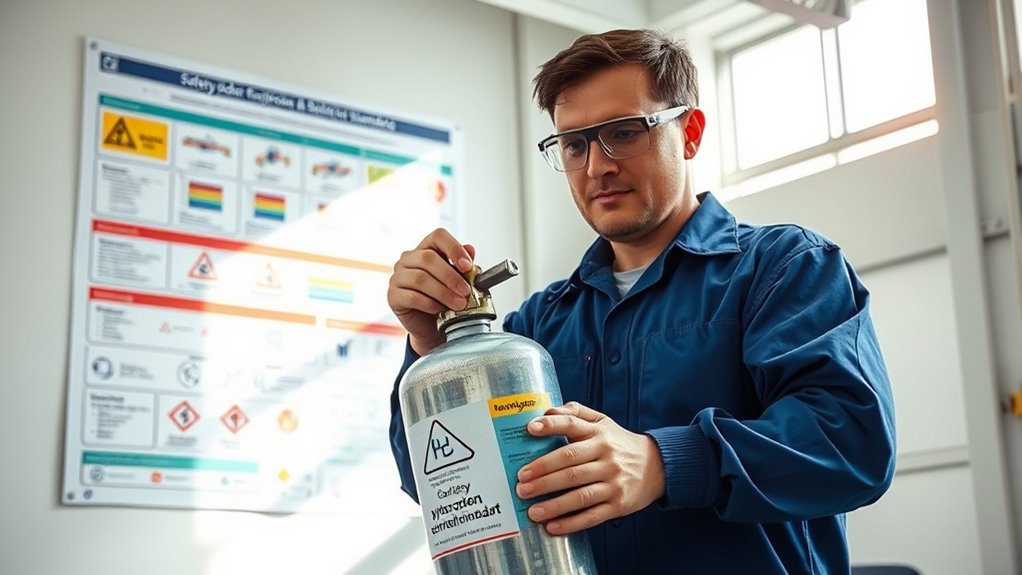
To guarantee safe handling of refrigerants, technicians must complete specialized training and obtain certification. This assures you understand the properties of hydrocarbon refrigerants and the safety protocols necessary to prevent accidents. Proper training covers topics like leak detection, proper installation, and emergency procedures. Certification verifies your knowledge and competence, which is often required by local or national regulations.
Key points to remember include:
- Ensuring you’re trained on hydrocarbon-specific safety standards
- Keeping certifications up-to-date with ongoing education
- Understanding the risks associated with improper handling
Compliance Testing and Certification Processes
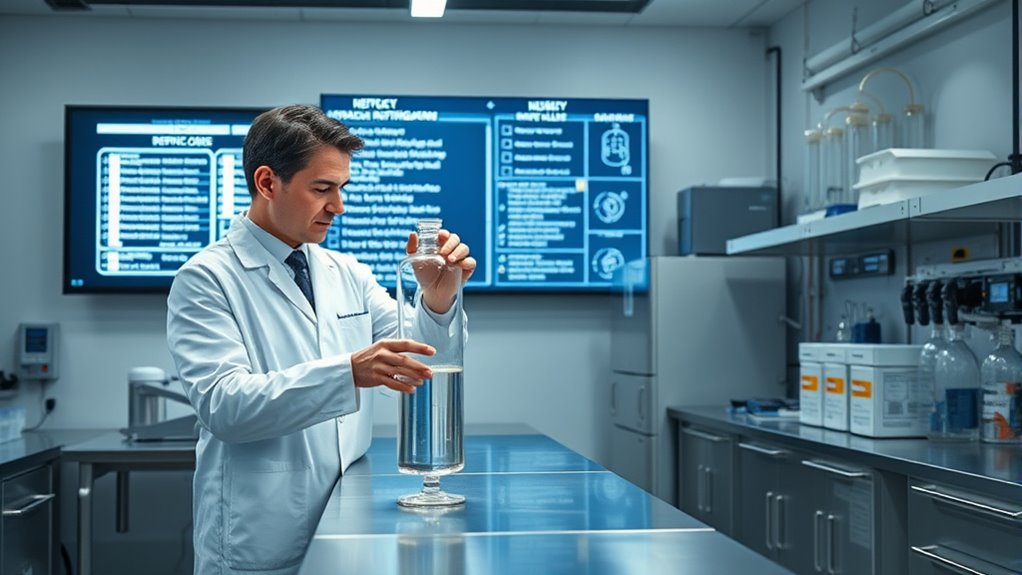
Compliance testing and certification are essential steps to guarantee technicians meet safety standards for handling refrigerants. You’ll need to undergo specific assessments that verify your knowledge of safety procedures, proper handling, and emergency protocols. These tests often include written exams and practical evaluations to ensure you understand the properties and risks associated with hydrocarbon refrigerants. Once you pass, you receive certification from authorized agencies, confirming your competence. This certification is usually valid for a set period, after which you must renew it through additional testing or continuing education. The process helps ensure that you and your colleagues work safely, reducing the risk of accidents or leaks. Following proper certification procedures not only keeps everyone safe but also ensures conformity with local and international safety codes.
Emergency Response and Incident Management

After obtaining your refrigerant safety certification, it’s vital to be prepared for emergencies that may arise during handling or accidental releases. Quick, effective incident management can prevent injuries and minimize damage. Your first step is to know your facility’s emergency procedures, including evacuation routes and spill containment. Always keep safety equipment accessible, such as fire extinguishers and spill kits. When an incident occurs, ensure that you:
Be prepared for refrigerant emergencies with quick action, safety gear, and clear procedures.
- Evacuate personnel immediately if there’s a fire or leak
- Shut off the refrigerant source to stop the release
- Alert emergency services and provide clear information
Future Trends and Ongoing Regulatory Developments
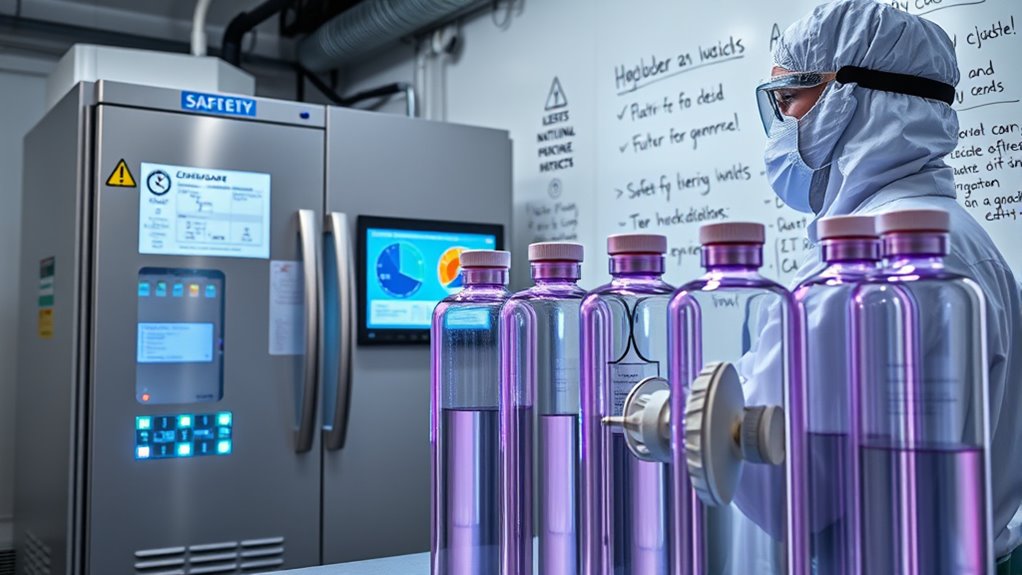
You’ll want to keep an eye on emerging safety standards that could reshape refrigerant regulations, making systems safer and more reliable. Efforts toward regulatory harmonization aim to streamline rules across regions, reducing confusion and improving compliance. Additionally, technological innovations are opening new possibilities for safer, more efficient refrigerant management, shaping future industry practices.
Emerging Safety Standards
How are emerging safety standards shaping the future of refrigerant management? They’re setting higher safety benchmarks as new refrigerants, like hydrocarbons, become more common. You’ll see standards evolving to address risks specific to these substances, such as flammability and toxicity. These updates promote safer handling, installation, and maintenance practices. Key trends include stricter testing protocols, clearer labeling requirements, and improved system design guidelines.
- Enhanced fire safety measures for flammable refrigerants
- More extensive leak detection and ventilation standards
- Updated training and certification requirements for technicians
These standards aim to minimize hazards while supporting technological innovation. Staying current ensures your compliance and safety in adopting emerging refrigerant technologies. As standards evolve, your awareness and adaptation will be vital for safe, efficient management.
Regulatory Harmonization Efforts
As safety standards for refrigerants continue to evolve, efforts to harmonize regulations across different regions are gaining momentum. You’ll notice international organizations, such as ISO and UNECE, working to create unified safety and environmental standards for hydrocarbon refrigerants. This push aims to reduce trade barriers, streamline compliance, and promote consistent safety practices worldwide. Governments are increasingly collaborating, sharing data, and adopting best practices to align their regulations. Such harmonization benefits manufacturers, installers, and consumers by simplifying certification processes and ensuring safer handling regardless of location. While disparities still exist, ongoing efforts aim to establish a cohesive global framework. This trend helps guarantee that safety codes keep pace with technological advancements and environmental objectives, ultimately fostering a safer, more sustainable refrigerant industry.
Technological Innovation Trends
Emerging technological innovations are shaping the future of refrigerant safety and regulatory standards. Advances in sensing, automation, and material science are making refrigerant systems safer and more efficient. You’ll see progress in leak detection technologies that enable real-time monitoring, reducing accidental releases. Additionally, new compressor designs and refrigerant blends improve performance while minimizing environmental impact. To stay compliant, you should focus on:
- Integrating smart sensors for early leak detection and system diagnostics
- Developing refrigerant mixtures that meet safety and efficiency standards
- Employing automation to enhance safety protocols and system controls
These innovations will not only ensure compliance but also promote safer, more sustainable refrigerant use. Staying abreast of these trends helps you adapt quickly and meet evolving safety codes effectively.
Frequently Asked Questions
What Are the Long-Term Health Effects of Hydrocarbon Refrigerant Exposure?
You might wonder about the long-term health effects of hydrocarbon refrigerant exposure. While short-term exposure can cause headaches or dizziness, there’s limited evidence of serious long-term health issues. However, prolonged or high-level exposure could potentially irritate your respiratory system or skin. To stay safe, follow safety guidelines, use proper protective equipment, and guarantee good ventilation. Regular monitoring and adherence to safety standards help minimize any potential health risks.
How Do Hydrocarbon Refrigerants Impact Environmental Sustainability?
Imagine your actions as planting a tree—what you do today shapes tomorrow’s environment. Hydrocarbon refrigerants impact sustainability by reducing greenhouse gases since they have a lower global warming potential compared to traditional refrigerants. You help the planet by choosing eco-friendly options, as these refrigerants contribute less to climate change. Embracing such sustainable practices guarantees cleaner air and a healthier future for everyone.
Are There Specific Disposal Procedures for Used Hydrocarbon Refrigerants?
You should follow specific disposal procedures for used hydrocarbon refrigerants to guarantee safety and environmental protection. First, avoid releasing them into the atmosphere, as they are flammable and can harm the environment. Instead, you need to store the refrigerants in approved containers and arrange for certified recycling or disposal services. Always adhere to local regulations and safety codes to prevent accidents and environmental damage.
Can Existing Refrigeration Systems Be Retrofitted for Hydrocarbon Use?
In the days of dial-up internet, you might think retrofitting is tricky, but it’s doable. You can retrofit existing refrigeration systems for hydrocarbon use if you follow safety codes and conduct thorough assessments. You’ll need to replace or modify components like compressors, valves, and seals, and guarantee proper ventilation. Always consult safety standards and a qualified technician to ensure compliance and safety before making any modifications.
What Are the Legal Liabilities Associated With Non-Compliance?
When you don’t comply with safety codes and regulations, you face serious legal liabilities. You could be fined, face lawsuits, or even criminal charges if an accident occurs due to non-compliance. Additionally, you might be held responsible for property damage or injuries. Non-compliance also risks your license or certification, which can halt your operations. It’s essential to follow all safety standards to protect yourself legally and guarantee safe system operation.
Conclusion
Think of hydrocarbon refrigerants as a delicate dance—when you follow safety codes and proper handling, everything flows smoothly. I once saw a technician spot a small leak early, preventing a bigger problem later. With over 90% of incidents avoidable through proper training and compliance, you hold the key to safe, efficient refrigeration. By staying informed and vigilant, you keep the dance graceful and safe for everyone involved.


